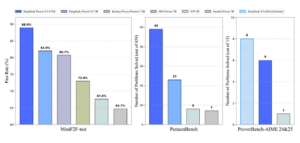IBM’s CEO Celebrates DeepSeek AI as a Success for His Strategy as Shares Rise 12%

Understanding Economic Inflation: A Simple Overview
Inflation is a term that often comes up in discussions about the economy, but what does it really mean? This article aims to explain the concept of inflation in easy-to-understand language.
What is Inflation?
Inflation refers to the general increase in prices of goods and services within an economy over a certain period. As prices rise, the purchasing power of currency declines. This means that, with the same amount of money, people can buy fewer goods and services than they could have in the past.
How is Inflation Measured?
Inflation is commonly measured through various indexes that track price changes over time. Here are the most common methods:
Consumer Price Index (CPI): This index measures the average price change over time for a basket of consumer goods and services, such as food, clothing, and rent.
Producer Price Index (PPI): This index looks at the average change in prices received by domestic producers for their output. It measures price changes at the wholesale level before they reach the consumer.
- Personal Consumption Expenditures (PCE) Price Index: This index measures the prices paid by consumers for goods and services and is often used by the Federal Reserve.
Types of Inflation
Demand-Pull Inflation: This type occurs when demand for goods and services exceeds their supply. When consumers are willing to pay more, prices rise.
Cost-Push Inflation: This happens when the costs of production increase, leading to higher prices for consumers. Factors such as rising wages or increased raw material costs can trigger this type of inflation.
- Built-In Inflation: Also known as wage-price inflation, this type arises when businesses increase prices to cover higher labor costs, which in turn pushes workers to demand higher wages.
Causes of Inflation
Several factors can drive inflation. Here are some of the most common:
Increased Money Supply: When central banks print more money, this often leads to higher prices because there’s more currency in circulation relative to goods.
Supply Chain Disruptions: Events like natural disasters, pandemics, or geopolitical tensions can interrupt supply chains, reducing the availability of goods and driving up prices.
- Rising Consumer Demand: When consumers have more disposable income (perhaps due to lower unemployment or stimulus checks), they tend to buy more, which can push prices higher.
Effects of Inflation
Inflation can have both positive and negative effects on the economy. Here are some important points to consider:
Erodes Purchasing Power: As prices rise, the value of money falls. People may struggle to afford everyday essentials if wages don’t keep pace with inflation.
Interest Rates: Central banks may raise interest rates to combat high inflation, making borrowing more expensive. This can slow down economic growth.
- Wages and Income: In times of moderate inflation, wages may also rise, allowing people to maintain their standard of living if their salaries keep up with price increases.
How to Protect Against Inflation
There are various strategies that individuals and investors can use to safeguard their finances against inflation:
Invest in Stocks: Historically, the stock market has outpaced inflation over the long term, making it a popular choice for growth-oriented investors.
Real Estate Investments: Property values often rise with inflation, making real estate a tangible asset that can provide a hedge against rising prices.
Commodities: Investing in commodities such as gold and silver can be a way to protect wealth since these assets often retain their value during inflationary periods.
- Inflation-Linked Bonds: These bonds, like Treasury Inflation-Protected Securities (TIPS), provide returns that keep up with inflation, ensuring that your investment maintains its purchasing power.
By comprehending the ins and outs of inflation, you can make informed decisions that may help protect your finances in uncertain economic times. Understanding its causes, effects, and ways to mitigate its impact is essential for anyone looking to navigate the complexities of financial planning effectively.






